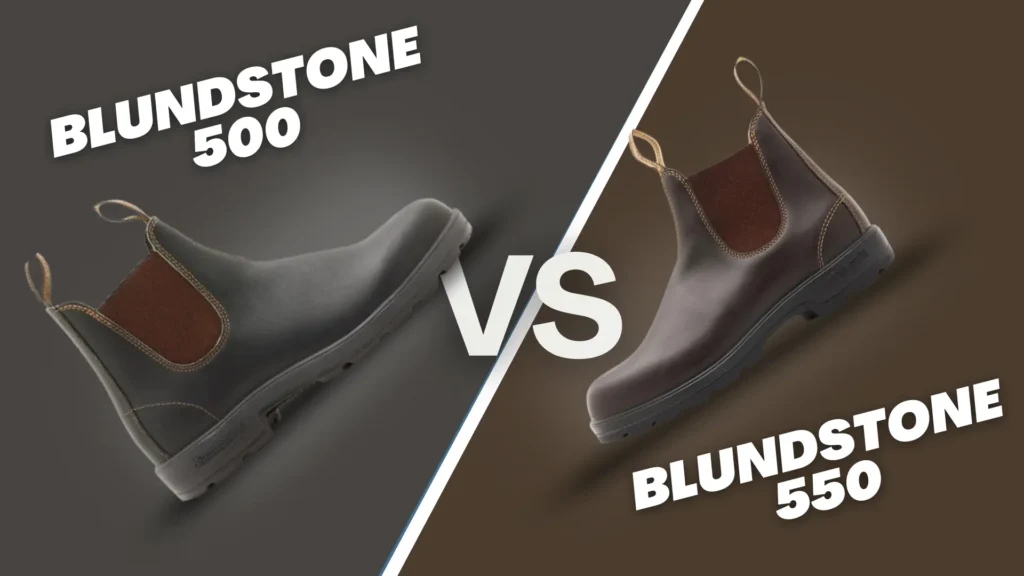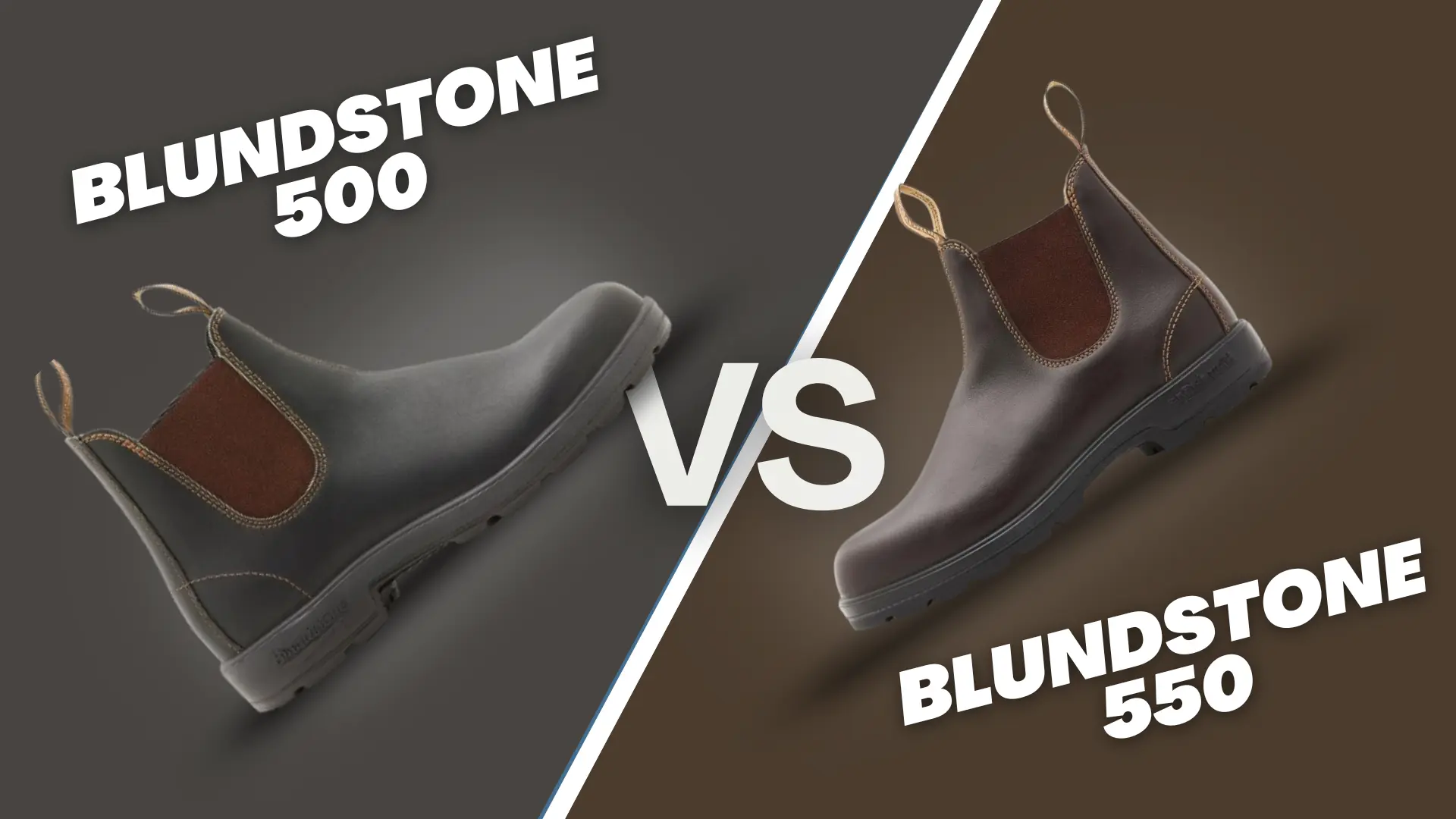
You know that moment when you’re eyeing two shoes that look almost identical and you’re stuck trying to decide between them?
And then, just to make things worse, your friend chimes in with their own recommendation, telling you to ditch one for the other. Yeah, it can get confusing real quick.
One of the biggest shoe dilemmas I’ve come across is the showdown between the blunnies Chelsea boots.
That’s why today I’m here to clear things up with a review of the Blundstone 500 and 550, just to help you figure out which one’s actually better.
Contents
Review of Blundstone 500 vs 550
I’ve broken down this review into four key categories: design, features, comfort, and price—just to make your decision a little easier.
Design
Starting with the design, there’s honestly not much difference between the two. Both boots rock that classic Chelsea boot style—which, let’s be real, looks pretty damn good.
The main difference you’re going to see is the stitching. The 550 has double stitching around the heel while the 500 keeps it simple with single stitching. Plus, the 550 throws in an extra stitch just below the gusset for a bit of added durability.
But aside from those small details, these boots are nearly identical in appearance.
Features
Now, let’s mention some of the features.
First off, both models use chrome-tanned aniline genuine leather. It’s high-quality leather, and honestly, there’s not much difference between the two in terms of quality.
The only real distinction is that the leather on the 550 is dyed all the way through, whereas the 500 is only surface-dyed.
At first glance, they look almost identical, but this detail sets them apart.
On the topic of leather, the 500s lack a leather lining, whereas the 550s have a leather lining around the ankle. This adds structure and durability to the 550s, giving them a more premium feel. So, that’s a downside for the 500 model.
Another downside of the 500s is the material Blundstone uses inside the toe box for added structure. The issue is you can see where this material is bonded, and it shows through on the exterior. (To me, it looks awful; I like more of a plain look.)
The 550s don’t have this problem thanks to their leather lining, which pairs better with the fabric toe box.
In terms of water resistance, both boots do a good job of keeping your feet dry. But don’t confuse water-resistant with fully waterproof—they won’t hold up in heavy rain or deep puddles.
Moving on to the soles, both models come with TPU outsoles—a material that’s strong, durable, and flexible, yet lightweight. The thickness of the soles also varies in both of these boots. (The 500s have a sole thickness of around 5 mm, while the 550s step it up to about 10 mm.)
The downside is these soles aren’t re-soleable, so keep that in mind for long-term use.
And lastly, both boots also feature removable footbeds, which is great if you use orthotics. However, the insoles in the 500s are pretty basic, so consider upgrading them for better comfort. The 550s come with two sets of insoles, allowing you to stack, swap, or mix and match for a better fit.
Must See: Why are Blundstone Boots Are So Expensive?
Comfort
Alright, let’s talk comfort for these boots, shall we?
Honestly, both pairs are super comfy to wear any time of the year—spring, winter, even summer. Well, maybe not on those blazing hot days, but they’re breathable enough and pretty versatile to pair with whatever outfit you’ve got going on.
And honestly, my favorite thing about these boots is that they got no annoying break-in period. The leather’s good to go right out of the box—you just slip ’em on and hit the road.
But here’s the thing: that elastic gusset can be a bit of a pain sometimes.
It kind of chokes your ankle a bit too tight at first. That’s something you’ll notice on both (500 and 550) models. You’ll need to break them in just a bit to get that gut to loosen up.
Other than that, I’ve worn both pairs for a full day, and they’re lightweight, flexible, and breathable. Perfect for walking, hiking, or travel.
Plus, the steel shank gives them a nice support and firm feel. The mix of TPU and steel shank adds a solid structure you won’t find in cheaper brands.
However, with the 550s, you get a bit more TPU and a thicker sole, which means better shock absorption and durability compared to the 500s. And the leather is dyed all the way, which just makes 550s a bit better choice.
So, comfort-wise, both of these boots really don’t disappoint, but 550 takes the win.
Related: Blundstone 550 vs 585
Fit
Generally, Blundstones fit true to size, and these boots are no different.
But heads up—the sizing chart is in Australian sizes, which can throw you off (trust me, I’ve been there). So, just take it easy and check Blundstone’s size guide to find your perfect fit.
Prices
Finally, let’s get to prices.
Both boots are priced below $200. The 500 comes in at around $170.96, while the 550 is about 10 dollars more. (Around $179.96)
There is not much of a difference here.
Final Thoughts: Which One Is Actually Better?
Blundstone 550 is, no doubt, a much better, more sophisticated choice if you’re looking for a solid pair of Chelsea boots. The 500 isn’t bad, but it’s missing a few features that don’t quite add up. The thinner sole, single leather dye, and slight design differences on the heel make it feel like a bit of an odd choice.
Again, I’m not saying it’s bad, but if you’re already spending around $200, I’d suggest saving up just 10 or 20 more for the 550. You’ll get better durability, comfort, and support with the 550 model.
The extra features you get with the 550 are totally worth it. You’re getting way more bang for your buck compared to the 500 model.
So yeah, the 500 is solid, but the 550? That’s the sweeter deal.
Alright, that’s a wrap for today. Hope this helps you decide between these two boots when you’re ready to buy!




